You’ll find acrylic paint works best for 3D printed miniatures because it bonds strongly with PLA and other plastics while drying quickly for efficient painting sessions. Choose affordable craft acrylics like Chromacryl or Artworks Acrylics for quality results without breaking your budget. These water-based formulas clean up easily with soap and water, and you can thin them for smoother application. Always prime your miniatures first using strong primers like Rustoleum to guarantee peak paint adhesion and prevent peeling over time. The techniques below will transform your miniatures into professional-quality pieces.
Understanding Paint Types for 3D Printed Miniatures
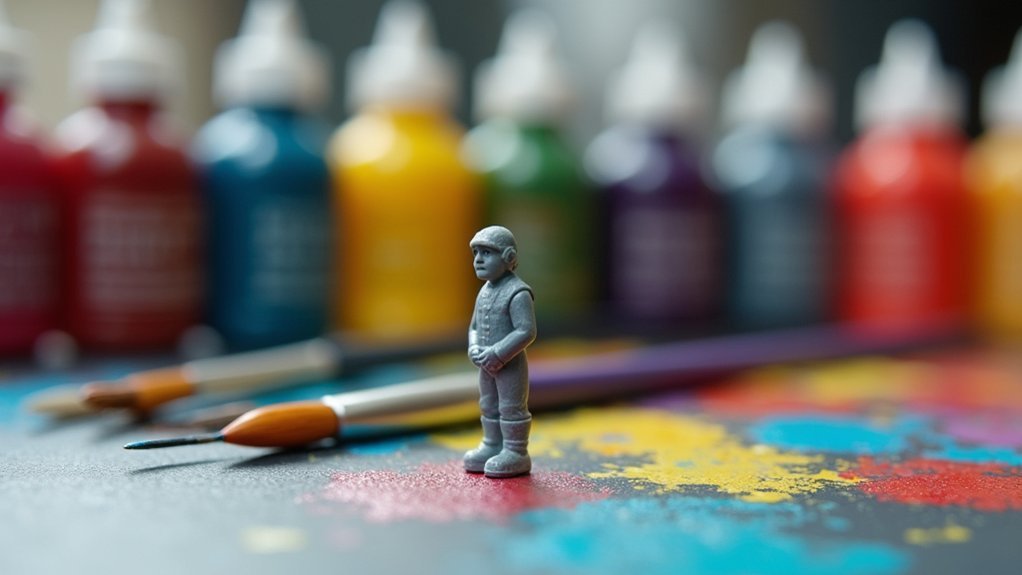
When you’re selecting paint for your 3D printed miniatures, acrylic paint stands out as the superior choice due to their user-friendly properties and excellent compatibility with common printing materials like PLA.
These paints dry quickly, allowing you to work efficiently without long waiting periods between coats. You’ll find acrylic paint adheres well to various surfaces and won’t damage your printed models.
Budget-conscious hobbyists can achieve excellent results with affordable craft acrylics like Chromacryl and Artworks Acrylics. These options deliver quality coverage without breaking the bank.
The water-based formula of acrylic paint makes cleanup simple with just soap and water. You can easily thin these paints for smoother application, creating professional-looking finishes on your miniatures.
Acrylic Paint Advantages and Application Techniques
You’ll find acrylic paints offer the best combination of ease and performance for your 3D miniatures.
They’re water-based, so cleanup is simple, and they dry quickly to keep your painting sessions moving.
Let’s explore why acrylics excel and how you can apply them for professional-looking results.
Acrylic Paint Benefits
Several key advantages make acrylic paints the top choice for painting 3D miniatures.
You’ll appreciate how water-based formulas clean up easily and dilute effortlessly, streamlining your painting process. These paints create strong bonds with PLA and other plastics, ensuring your work won’t peel or flake over time.
The quick-drying properties let you build layers rapidly and add intricate details without lengthy waiting periods.
When you thin acrylics with water or medium, you’ll achieve smoother coverage that preserves fine details on your miniatures.
The acrylic paint benefits extend to finish variety – you can choose from matte, satin, or gloss options to customize your miniatures’ final appearance.
This versatility makes acrylics ideal for both beginners and experienced painters.
Proper Application Methods
Mastering the right application techniques transforms your acrylic painting results from amateur to professional quality.
You’ll need a strong primer like Rustoleum to guarantee proper paint adhesion on your PLA miniatures, creating the essential foundation for lasting results.
Apply multiple thin coats rather than one thick layer. This technique enhances coverage while preventing drips and uneven texture that ruin your miniature’s appearance.
Thin your acrylic paint with water for smoother application when needed.
Choose your brush size strategically—fine brushes for detailed areas and larger brushes for broad surfaces. This approach guarantees precision where it matters most.
Don’t rush the process. Allow adequate drying time between each layer to prevent smudging and guarantee proper adhesion.
Patience here makes the difference between mediocre and exceptional results.
Surface Preparation and Priming Methods
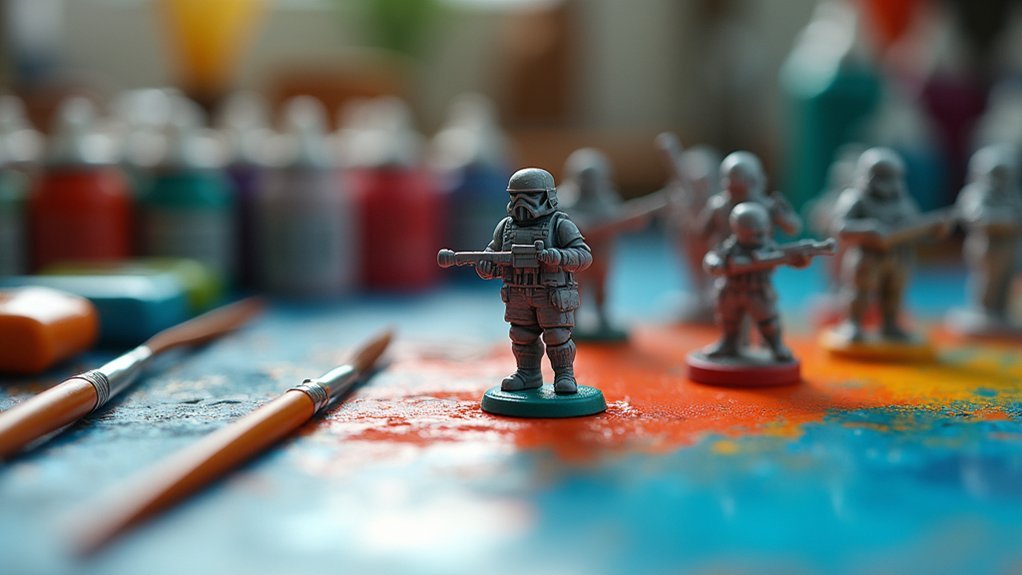
You’ll need to choose the right primer and determine whether sanding is necessary before painting your 3D printed miniatures.
Rattle can primers like Rustoleum greatly improve paint adhesion and create a durable finish, while matte PLA filaments often don’t require sanding due to their smoother surface texture.
Your primer selection should consider both the material you’re working with and the painting techniques you’ll use, as a strong colored undercoat enhances dry-brushing effects and overall depth.
Primer Selection Techniques
While many painters rush straight to applying color, proper primer selection and surface preparation form the foundation of any successful miniature paint job.
When painting 3D printed models, you’ll want to use a strong primer like Rustoleum to guarantee superior paint adhesion and durability. Your primer selection techniques should prioritize black undercoats, which create natural depth and enhance contrast for subsequent dry-brushing layers.
Rattle can primers offer the most convenient coverage for detailed miniatures.
Before applying any primer, clean your model thoroughly and sand rough areas to improve finish quality. Always test your chosen primer on a small section first to verify compatibility.
This preparation step prevents paint failure and guarantees your miniature painting project achieves professional-quality results.
Sanding Requirements Guidelines
Building on proper primer selection, understanding when and how to sand your 3D printed miniatures determines whether your paint job looks amateur or professional. You’ll need to assess your print’s surface quality before deciding on sanding requirements.
| Print Quality | Sanding Needed | Grit Recommendation |
|---|---|---|
| Rough/Layer Lines | Yes | 220-400 grit |
| Smooth PLA | Light sanding | 400-600 grit |
| Matte Filament | No | N/A |
Start with higher grit numbers for delicate details to avoid removing fine features. Always clean dust and residue after sanding before applying primer. For most PLA miniatures, light sanding with 400-grit sandpaper improves paint adhesion considerably. Skip sanding entirely if you’re using matte filaments, as their natural texture provides excellent paint grip without additional preparation.
Essential Tools and Equipment for Miniature Painting
Having the right tools makes all the difference between frustrating painting sessions and enjoyable ones that produce professional-looking results.
You’ll need various paintbrush sizes to handle intricate details and broader coverage areas effectively. A mixing palette lets you create custom colors and control how the best paint appears on your miniatures.
Keep a water container nearby for rinsing brushes between applications, preventing paint from drying on bristles and maintaining brush quality.
Don’t forget preparation tools like cutting implements, files, and sandpaper to smooth 3D print surfaces for better paint adhesion.
Set up adequate lighting and ventilation in your workspace. Good lighting helps you see fine details clearly, while proper ventilation guarantees safe use of paints and sealants during extended painting sessions.
Budget-Friendly Paint Options That Deliver Quality Results
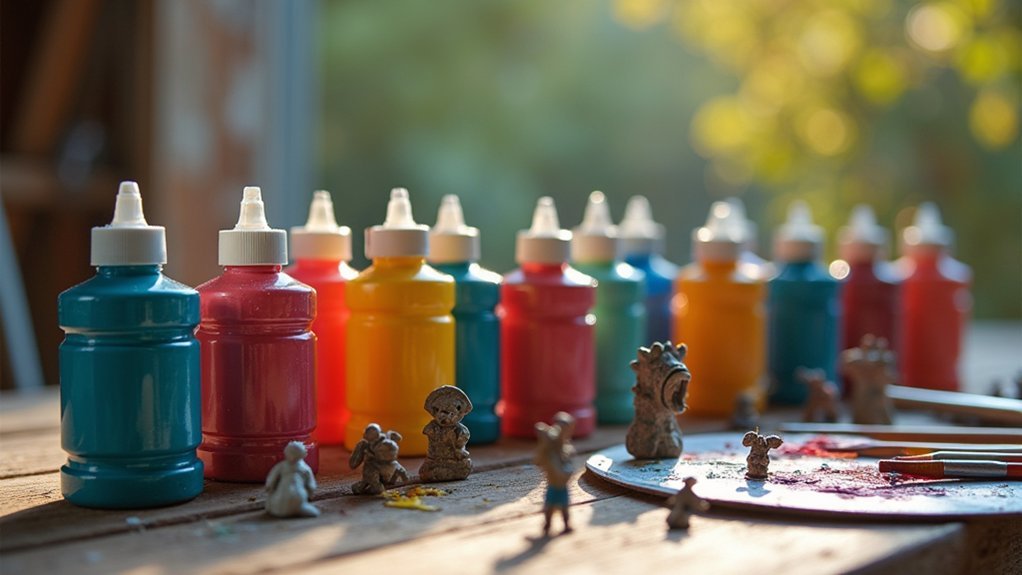
When you’re starting out with miniature painting, expensive hobby paints aren’t necessary to achieve impressive results. Budget-friendly paint options like Chromacryl and Artworks Acrylics provide excellent color coverage and easy application for your 3D printed miniatures. Resene test-pots offer smooth application and color fastness, making them perfect for base colors without breaking the bank.
| Paint Type | Cost per Bottle | Quality Rating |
|---|---|---|
| Hobby Paints | $4-8 | Excellent |
| Chromacryl | $2-3 | Very Good |
| Test Pots | $1-2 | Good |
| Artworks Acrylics | $1-3 | Good |
Remember to use strong primers like Rustoleum for better adhesion, thin your acrylics for smoother coverage, and seal with rattle can clear poly for lasting protection.
Advanced Techniques: Dry-Brushing and Weathering Effects
Once you’ve mastered basic paint application with budget-friendly options, dry-brushing and weathering techniques will transform your miniatures from simple painted figures into realistic, battle-tested characters.
Dry-brushing uses a brush with minimal paint to highlight raised surfaces like armor details and weapon edges. You’ll want lighter shades of your base color for best results.
Weathering effects create authenticity through strategic aging and wear patterns.
Essential techniques for advanced miniature painting:
- Apply washes to recesses – Use diluted paint in grooves and crevices to create natural shadows and depth.
- Use weathering powders strategically – Add rust, dirt, and battle damage with pigments for realistic aging effects.
- Combine dry-brushing with weathering – Layer both techniques to achieve dynamic textures and professional-quality finishes.
Sealing and Protective Coatings for Long-Term Durability
After investing hours perfecting your miniature’s paint job through advanced techniques, you’ll want to protect that work with proper sealing and protective coatings.
Clear matte varnish stands as the top choice for sealing miniatures, providing essential protection while preserving your paint’s original appearance. You can apply it using rattle can sprays for even coverage or brush-on sealants for detailed control in intricate areas.
| Application Method | Best For | Key Benefits |
|---|---|---|
| Rattle Can Spray | Large batches | Even coverage, quick application |
| Brush-On Sealant | Detailed areas | Precise control, no overspray |
| Multiple Thin Coats | All miniatures | Better adhesion, prevents runs |
| Regular Resealing | Display pieces | Extended lifespan, prevents fading |
Apply multiple thin coats rather than one thick layer to guarantee proper adhesion and avoid drips. Regular sealing considerably extends your miniatures’ lifespan by preventing chipping and fading from handling.
Troubleshooting Common Paint Adhesion Issues
Even with quality paints and careful preparation, you might encounter frustrating adhesion problems that can ruin your miniature’s finish. When paint won’t stick to your printed dollhouse miniatures, several solutions can salvage your project.
Common Adhesion Solutions:
- Surface contamination – Clean your miniature with isopropyl alcohol to remove oils, dust, or fingerprints that prevent proper bonding between paint and plastic.
- Skip the primer mistake – Apply Rustoleum or similar primer to create the rough surface texture that paint needs to grip effectively onto smooth 3D printed surfaces.
- Paint consistency problems – Thin your acrylics slightly and apply multiple thin coats rather than one thick application, allowing each layer to cure completely before adding the next.
Test paint adhesion on hidden areas first to identify potential reactions.
Workshop Setup and Space Considerations for Miniature Painting
Creating an organized workspace transforms your miniature painting from a frustrating scramble to an enjoyable, productive hobby.
A well-organized workspace is the foundation that turns chaotic miniature painting sessions into smooth, enjoyable creative experiences.
You’ll need adequate lighting through desk lamps or natural sources to enhance detail visibility. Proper ventilation becomes essential when working with certain paints and sealants for safety and comfort.
Storage solutions like bins or shelves keep your paints, brushes, and tools organized and accessible, preventing mix-ups or damage.
Consider designating space for a spray booth or priming area to minimize overspray and maintain cleanliness when applying primers and sealants.
Whether you’re working with an existing setup or starting a new account with suppliers, prioritize organization and accessibility.
Your dedicated workspace should facilitate efficient workflow while protecting your investment in quality paints and tools.
Frequently Asked Questions
What Kind of Paint Do You Use on 3D Models?
You’ll want acrylic paints for your 3D models since they adhere well to plastic. Use cheap craft acrylics like Chromacryl, prime with Rustoleum first, thin your paint, and seal with matte varnish.
What Type of Paint Do I Use for Miniatures?
You’ll want acrylic paints for miniatures since they adhere well to plastic surfaces. Use rattle can primer first, then apply thinned acrylics for smooth coverage. Finish with clear matte varnish for protection.
Can I Paint 3D Printed Objects Without Primer?
You can paint 3D printed objects without primer, but you’ll risk poor paint adhesion and durability. Use matte filament or lightly sand glossy surfaces for better results when skipping primer.
Will Any Acrylic Paint Work on Miniatures?
You can use most acrylic paints on miniatures since they adhere well to PLA plastic. However, you’ll get better results if you thin the paint and always test it first.


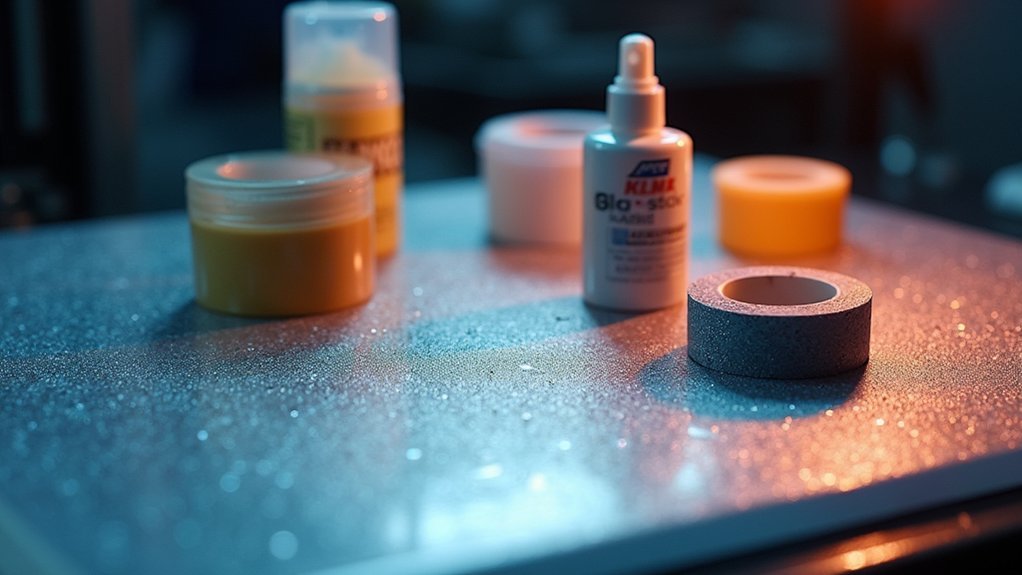
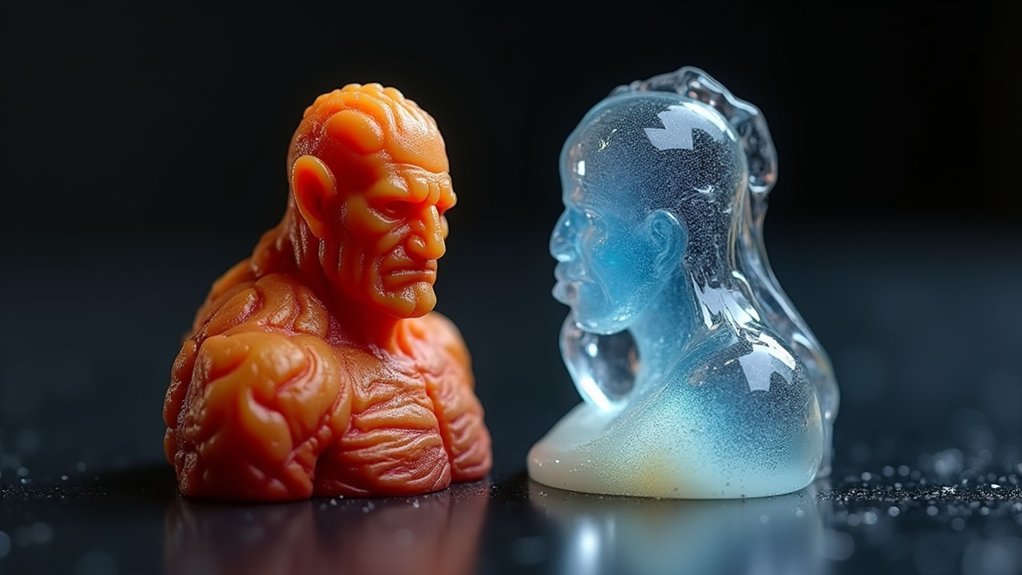
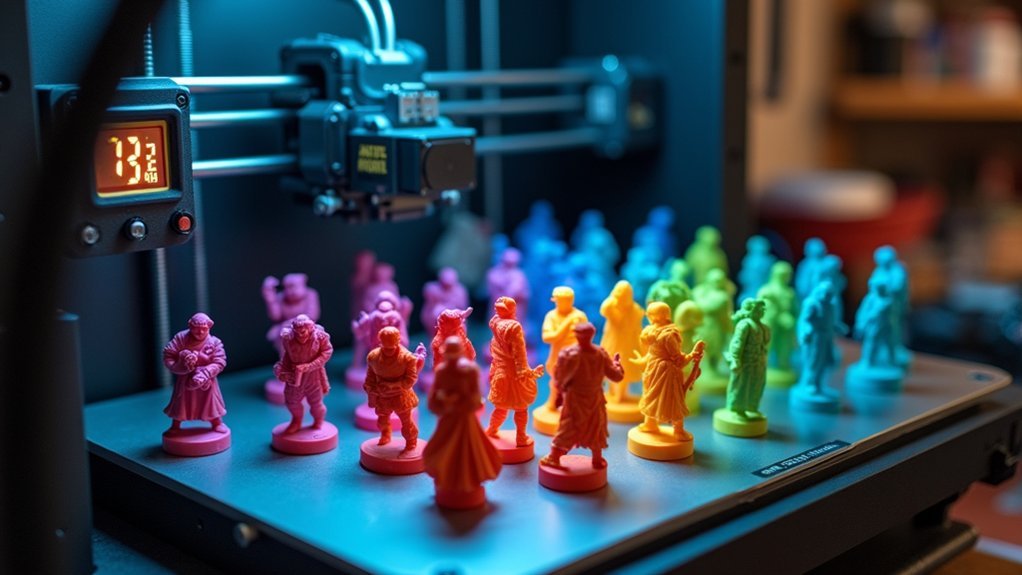
Leave a Reply